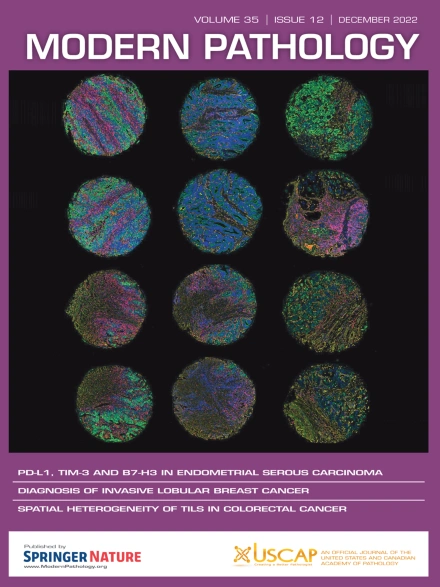伴有 RET 融合的 Spitz 肿瘤的临床、形态学和基因组研究结果:31 例系列病例。
IF 7.1
1区 医学
Q1 PATHOLOGY
引用次数: 0
摘要
ret融合的Spitz肿瘤罕见且特征不明确。我们描述了31例伴有RET融合的Spitz肿瘤的临床、组织学和分子表现,其中16例为Spitz痣(SN), 13例为非典型Spitz肿瘤(AST), 2例为Spitz黑色素瘤(SM)。病变主要发生在儿童和青年男女,并倾向于四肢。镜下,主要为对称的复合型黑色素细胞肿瘤,轮廓呈圆顶状/微凸起,主要由上皮样、纺锤状和/或较小的网状黑色素细胞组成,排列在融合巢中。病变上部巢内的黑素细胞粘连不全、卡米诺小体突出、巨大的多核黑素细胞、可变色素沉着和血管扩张增加是常见特征。RNA测序检测到9个不同的5‘ (n -端)融合伙伴,包括KIF5B (n= 8)、LMNA (n= 7)、CCDC6 (n= 6)、OPTN (n= 3)、MYO5A (n= 2)和NCOA4、ERC1、MYH9、AGAP3 (n= 1)。其中,OPTN::RET和AGAP3::RET代表了新的融合体,另外3个5’融合伙伴,即NCOA4、ERC1和MYH9在Spitz肿瘤中从未报道过。虽然作为一个整体,肿瘤表现出异质的组织病理学表现,但形态学特征和5'融合伴侣的相关性显示出一定的相关性。瘤状黑素细胞只出现在KIF5B融合伴侣的病例中。两例myo5a融合病例均表现为神经样样外观,梭形细胞束相交。上皮样黑素细胞群体以LMNA和CCDC6融合伴侣为主。OPTN亚组观察到色素梭形和上皮样黑素细胞经表皮消除/表皮内漂浮巢。其余5′融合体较少的病例一般表现为更不典型的组织病理特征,包括核多形性、高有丝分裂计数、不典型有丝分裂和片状生长模式。针对RREB1、MYC、CDKN2A和CCND1的黑色素瘤荧光原位杂交(FISH)探针试剂盒在4例检测病例中拷贝数变化呈阴性,其中2例免疫组化显示p16核完全缺失。阵列比较基因组杂交(aCGH)在3个病变中检测到2例诊断为SM的患者中存在大量染色体不平衡。DNA和RNA测序检测到几个进一步的基因组改变,包括在3个高度色素沉着的病变中过度表达POU2F3。需要进一步的研究来证实在ret融合的Spitz肿瘤中显微镜特征与特定融合伙伴(或其他遗传事件)之间可能存在的相关性。本文章由计算机程序翻译,如有差异,请以英文原文为准。
Clinical, Morphologic, and Genomic Findings in Spitz Tumors With RET Fusion: A Series of 31 Cases
RET-fused Spitz neoplasms represent a rare and poorly characterized category of Spitz tumors. Here we describe the clinical, histologic, and molecular findings of 31 Spitz neoplasms with RET fusion diagnosed as Spitz nevus (n = 16), atypical Spitz tumors (n = 13), and Spitz melanoma (n = 2). The lesions mainly occurred in children and young adults of both sexes with a predilection for the extremities. Microscopically, they were mainly symmetrical compound melanocytic neoplasms with a dome-shaped/slightly raised silhouette predominantly composed of epithelioid, spindled, and/or smaller nevoid melanocytes arranged in confluent nests. Dyscohesive melanocytes within the nests in the upper part of the lesions, prominent Kamino bodies, giant multinucleated melanocytes, variable pigmentation, and increased vascularity with vascular ectasia were frequent features. RNA sequencing detected 9 different 5’ (N-terminus) fusion partners, including KIF5B (n = 8), LMNA (n = 7), CCDC6 (n = 6), OPTN (n = 3), MYO5A (n = 2), and NCOA4, ERC1, MYH9, AGAP3 (n = 1). Of these, OPTN::RET and AGAP3::RET represent novel fusions, and 3 further 5’ fusion partners, namely NCOA4, ERC1, and MYH9, have never been reported in Spitz tumors. Although as a whole group, the tumors showed a heterogeneous histopathologic presentation, correlation of the morphologic features and the 5' fusion partners demonstrated certain associations. Nevoid melanocytes were exclusively encountered in cases with KIF5B fusion partner. Neuroid-like appearances with intersecting fascicles of spindled cells typified both MYO5A-fused cases. Epithelioid melanocyte population dominated cases with LMNA and CCDC6 fusion partners. Transepidermal elimination/floating intraepidermal nests of pigmented spindled and epithelioid melanocytes were observed in the OPTN subgroup. The remaining cases with less frequent 5’ fusion partners manifested in general more atypical histopathologic features, including nuclear pleomorphism, high mitotic count, atypical mitoses, and sheet-like growth pattern. Melanoma fluorescence in situ hybridization probe kit targeting RREB1, MYC, CDKN2A, and CCND1, was negative for copy number variation in 4 cases tested, including 2 cases with complete p16 nuclear loss on immunohistochemistry. Array comparative genomic hybridization was performed in 3 lesions and detected numerous segmental chromosomal imbalances in 2 of them that were diagnosed as Spitz melanoma. DNA and RNA sequencing detected several further genomic alterations, including POU2F3 overexpression in 3 highly pigmented lesions. Further studies are needed to confirm possible correlations between the microscopic features and a particular fusion partner (or additional genetic events) in RET-fused Spitz neoplasms.
求助全文
通过发布文献求助,成功后即可免费获取论文全文。
去求助
来源期刊

Modern Pathology
医学-病理学
CiteScore
14.30
自引率
2.70%
发文量
174
审稿时长
18 days
期刊介绍:
Modern Pathology, an international journal under the ownership of The United States & Canadian Academy of Pathology (USCAP), serves as an authoritative platform for publishing top-tier clinical and translational research studies in pathology.
Original manuscripts are the primary focus of Modern Pathology, complemented by impactful editorials, reviews, and practice guidelines covering all facets of precision diagnostics in human pathology. The journal's scope includes advancements in molecular diagnostics and genomic classifications of diseases, breakthroughs in immune-oncology, computational science, applied bioinformatics, and digital pathology.
 求助内容:
求助内容: 应助结果提醒方式:
应助结果提醒方式:


